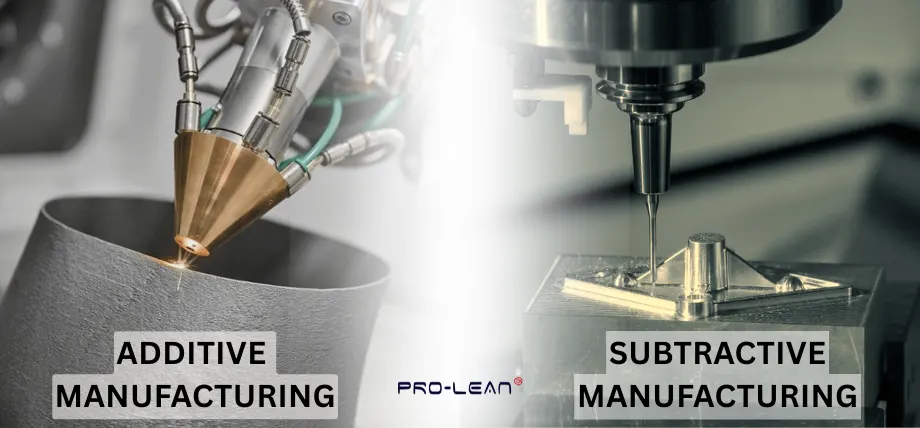
Additive manufacturing and subtractive manufacturing are two processes that lie within the wide range of modern manufacturing. Both of these have different methods and advantages, employing two distinct approaches.
After reading this article, you’ll have a better understanding of additive and subtractive manufacturing processes, their associated costs, and key details, while also diving into the integration of hybrid manufacturing with additive and subtractive technologies.
What is Subtractive Manufacturing?
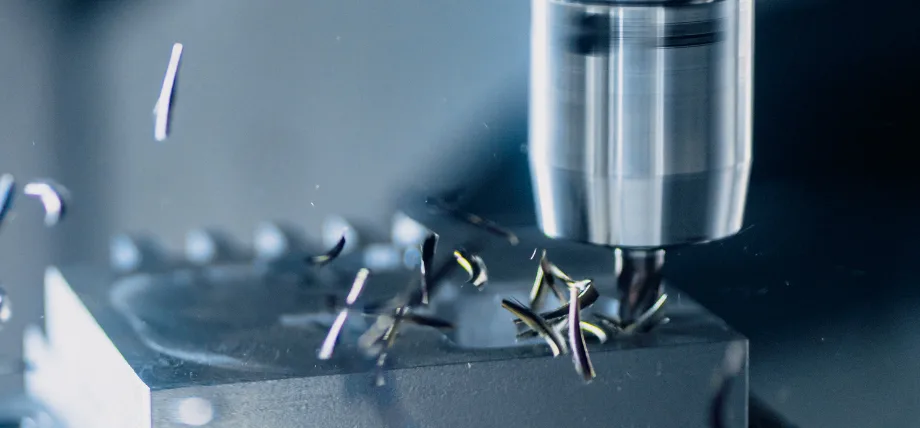
Subtractive machining is shown by material removal
Subtractive manufacturing forms a workpiece by the process of removing material, slowly turning the workpiece into its desired shape. The subtractive process of this manufacturing method uses machine tools, such as CNC machines, for material removal.
Subtractive manufacturing has long been a major processing method, the term subtractive manufacturing refers to a wide range of processes where the material is removed to create parts from 3D model data.
The subtractive manufacturing process starts by removing material from a solid block to shape the workpiece, using cutting tools with modern machines such as drills and milling machines paired with computer numerical control (CNC) guiding the machining process carefully.
The basic principle of the process is that subtractive manufacturing removes material to create complex geometries with high tolerance and surface finish.
What are the Common Subtractive Manufacturing Methods?
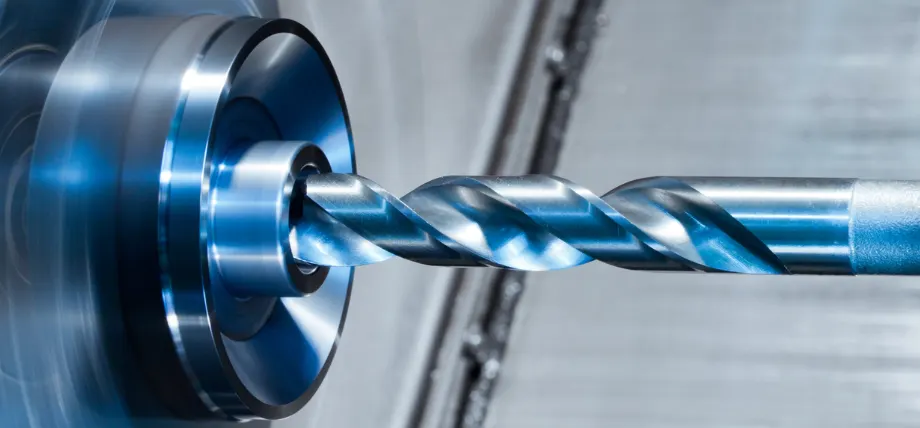
CNC drilling on a turning machine
The common subtractive processes include various methods that serve different applications. The main types of subtractive methods include:
- Milling: The milling process uses advanced 5-axis milling machines to remove material, forming a workpiece with complex geometries. The depth of the cut and types of cutting tools vary depending on the material selection and desired outcome.
- Turning: The turning process rotates the workpiece with high precision while a cutting tool slowly removes material to form the final product. It results in cylindrical parts.
- Drilling: This process uses a drill to create holes in the workpieces that require precise hole positions.
- Grinding: Grinding is a simple process that uses an abrasive wheel to remove small amounts of material to produce a high-quality surface finish with tight tolerances.
- Electrical Discharge Machining (EDM): The EDM machining is a unique process that uses electrical discharges (spark) to vaporize metal, forming workpieces with high precision.
The common subtractive processes include turning, drilling, and milling, which are executed using industrial machines or desktop machines to large equipment in machine shops.
Subtractive manufacturing tools are available today in various forms, which cater to both small-scale and large-scale production needs.
Materials in Subtractive Manufacturing
Subtractive manufacturing offers a wide range of material selection, giving versatility to the process. Some of the most commonly used materials are listed below:
- Metals: Metals are the most commonly used material in subtractive manufacturing due to their outstanding properties, which are ideal for making precision components to be used in the aerospace and automotive industries.
- Plastics: Nylon and ABS plastics are used to make precision components that are used in various applications that need to be lightweight.
- Composites: polymer composites, such as carbon fiber, can be processed using special cutting tools to make high-performance parts.
- Wood and Ceramics: These materials are machined only for specific applications, such as furniture or custom components.
The ability to machine diverse materials makes subtractive manufacturing a preferred choice for industries requiring high-precision parts.
Try Prolean Now!
What is Additive Manufacturing?
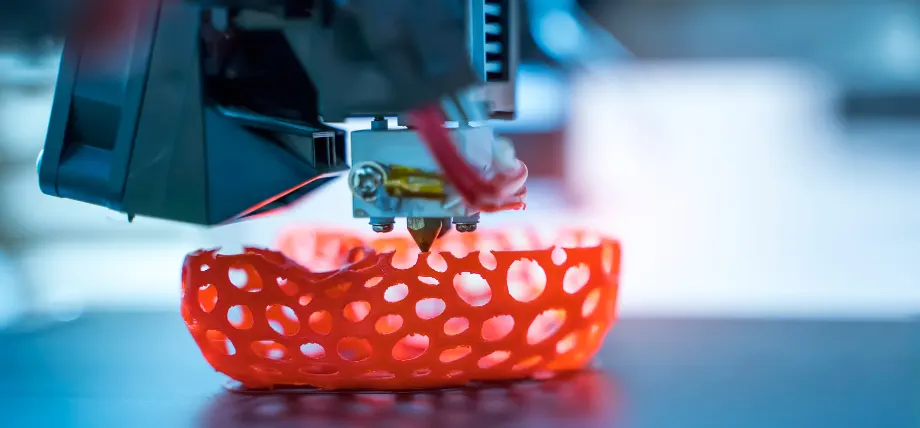
3D printing
Additive manufacturing is also known as 3D printing and is a widely used manufacturing process that builds objects layer by layer by using a CAD 3D model to guide the 3D printer.
Additive manufacturing, also known as additive fabrication, is the opposite of subtractive manufacturing. Subtractive manufacturing works by removing material, whereas additive manufacturing adds material to achieve a desired shape.
The most common technique that utilizes additive manufacturing is the 3D printing process that produces precise components with complex geometries.
Some common additive manufacturing processes include techniques such as fused deposition modeling (FDM), stereolithography (SLA), and selective laser sintering (SLS), each having different applications.
Additive manufacturing technologies have made prototyping and small-batch production easier and are readily available due to highly versatile 3D printing.
Additive Manufacturing Technologies
Additive manufacturing is a highly versatile process, which has various manufacturing techniques with unique capabilities:
- Fused Deposition Modeling (FDM): This process is commonly known as 3D printing and works by depositing plastic or polymer filament through a nozzle layer by layer to create a workpiece. FDM is frequently used in desktop additive and subtractive manufacturing due to its affordability and ease of use.
- Stereolithography (SLA): SLA is a process that utilizes a laser to cure resin into solid parts with a smooth surface finish.
- Selective Laser Sintering (SLS): SLS fuses metal or plastic into solid components for use in various applications.
- Direct Metal Laser Sintering (DMLS): This process is similar to SLS and is used for 3D printed metal parts, allowing the production of metal components.
These additive technologies are supported by easy-to-use desktop additive and subtractive manufacturing systems, as well as large industrial machines, making additive manufacturing accessible across various industries.
What Materials Can Be Used in Additive Manufacturing?
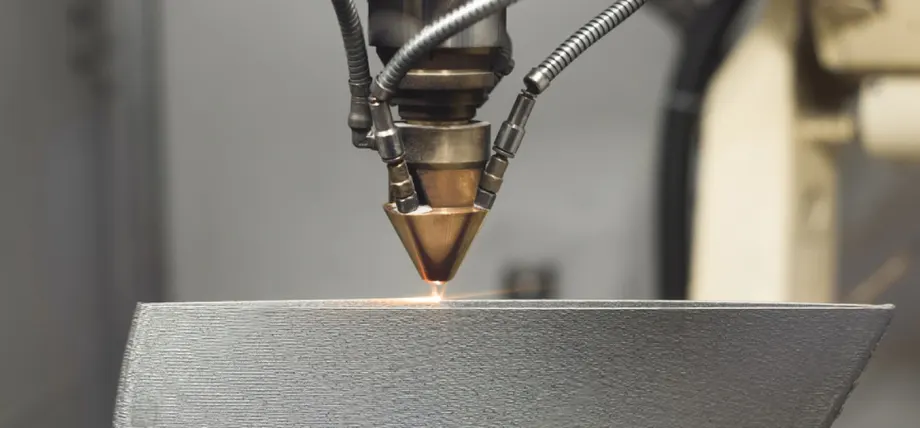
Additive manufacturing supports a wide range of materials, enabling flexibility in design and application. Common materials include:
Plastics: Plastics are the most commonly used material for additive manufacturing, due to their cost-effectiveness, seamless printing process, and quality.
Metals: Metals are tough and durable. This makes them useful in a wide range of applications. Materials like titanium and alloys are often machined using CNC machines.
DMLS Additive process is used to manufacture high-strength precision components used in heavy industries
Composites: Reinforced polymers such as carbon fiber and glass-filled materials are lightweight and exhibit high performance, which is ideal for the automotive industry.
Resins: SLA is a resin curing process that has high detail and a smooth surface finish, ideal for jewelry.
Ceramics and Biocompatible Materials: These materials have a very niche application, such as implants, and have a lot of variation, so additive manufacturing, such as 3D printing, is ideal for biocompatibility.
Subtractive and Additive Manufacturing: Key Differences
Additive and subtractive manufacturing differ fundamentally in their approach to material manipulation, impacting their applications and outcomes.
| Aspect | Subtractive Manufacturing | Additive Manufacturing |
| Process | Removes material from a solid workpiece via cutting tools | Builds parts layer by layer by adding material |
| Equipment | Use CNC machines like mills, drills, and turning centers | Uses 3D printers guided by CAD software |
| Material Efficiency | Generates material waste | Minimizes waste by using only the material needed |
| Geometric Complexity | Limited to geometries accessible by cutting tools | Excels at complex geometries, |
| Precision and Finish | Achieves high precision, tight tolerances, and excellent surface finishes | May require post-processing |
| Production Volume | Cost-effective and rapid machining processes. | Ideal for low-volume, customized, or prototype parts |
Process and Methodology
Subtractive manufacturing involves material removal processes, such as milling, turning, and drilling, which are performed using CNC machining.
Subtractive manufacturing is a highly precise and detailed process. It’s guided using computer numerical control and can process metal, plastic, and composite workpieces.
Additive manufacturing is the opposite of subtractive manufacturing. Additive processes work by slowly printing material layer by layer using 3D printers.
Equipment and Setup
Subtractive processes utilize a 5-axis CNC mill and machine tools to precisely machine excess material, forming the workpiece. Reducing cycle time in CNC improves the overall efficiency of the setup.
Additive manufacturing utilizes 3D printers paired with CAD models to create the workpiece.
The 3D printers can range from Desktop machines to large industrial equipment that can produce parts at a large scale with high efficiency.
Material and Waste
Subtractive manufacturing removes material and creates waste, which can increase the cost of precious metal parts. On the other hand, Additive manufacturing prints the material through a tip, making it more efficient.
3D printing does require support for the components to maintain proper structure and keep the print secure
Design Flexibility
Additive manufacturing is versatile and can create complex geometries with ease. It is supported by CAD, which enables it to create complex designs such as hollow components, which is not possible using subtractive methods.
Subtractive manufacturing is limited to specialized tools and tool and material machining capabilities.
Try Prolean Now!
What are the Advantages of Subtractive Manufacturing?
Subtractive manufacturing offers several advantages when compared to other machining processes. Some of which are mentioned below:
- High Precision and Tolerances: Subtractive CNC processes can achieve tight tolerances with consistent finishes using 5-axis machining,
- Material Versatility: Subtractive manufacturing can process a wide range of materials, ranging from metals and plastics, composites, catering to a multitude of applications.
- Established Infrastructure: Subtractive manufacturing tools are available in most machine shops, supported by decades of technological development and skilled labor.
- Durability: Parts produced through subtractive processes are often monolithic, offering superior strength compared to some 3D printed components.
What are the Advantages of Additive Manufacturing?
Additive manufacturing offers unique benefits that complement subtractive methods:
- Complex Geometries: Additive processes enable the creation of intricate designs, including internal structures and lattice patterns, without the need for specialized tooling.
- Rapid Prototyping: The 3D printing process is fast and efficient, enabling quick refining and development, which can identify any flaws before mass production.
- Material Efficiency: Additive manufacturing does not produce excessive waste material and only utilizes the material needed to produce the workpiece. It does not produce waste like subtractive material.
- Customization: Additive manufacturing is highly customizable, so producing low-volume and personalized products is easy.
Price of Additive Manufacturing vs. Subtractive Manufacturing
The manufacturing cost of additive and subtractive processes can vary depending on the material and machine type. The table below compares key cost factors:
| Cost Factor | Subtractive Manufacturing | Additive Manufacturing |
| Equipment Costs | High initial cost in CNC machines, mills, and lathes. | Desktop 3D printers (cheap) to expensive industrial machines; lower maintenance. |
| Material Costs | Higher due to waste from material removal. | Lower material waste; metal powders can be expensive. |
| Labor Costs | Requires a skilled CNC machinist | Lower labor costs for desktop systems |
| Production Volume | Cost-effective for high-volume machining processes. | More economical for low-volume or custom parts |
| Tooling and Setup | Requires custom fixtures and tools, increasing cost | Minimal tooling costs |
| Post-Processing | Minimal post-processing | May require significant post-processing |
Subtractive manufacturing costs more due to the need for CNC machines and cutting tools. Apart from that, it produces waste, which requires specialized tools, increasing the costs exponentially when working with metals. However, it is cost-effective for high-volume production.
In the case of Additive manufacturing, it does not produce material waste but does have a higher material cost due to specialized polymer and metal powders.
It is affordable and best suited for small-scale batch production of components with complex geometries.
Choosing Between Additive and Subtractive Manufacturing
Both processes produce highly detailed workpieces that are utilized in various applications across different industries.
Choosing between additive and subtractive manufacturing can depend on the project and material properties
In some cases, combining both additive and subtractive manufacturing to make a hybrid process gives the best, but this process requires thorough project evaluation and material behaviour assessment results.
Design and Geometric Complexity
Producing complex Geometries, such as internal lattices and hollow components, can easily be made using additive manufacturing. These geometries are impossible to make using subtractive methods.
Subtractive manufacturing can produce simple geometries with high precision, but cannot create internal geometries due to accessibility issues, since the tool cannot read inside the workpiece.
Material Requirements
Subtractive manufacturing is versatile and can process a wide range of materials with high precision and efficiency, which includes metals, plastics, and composites various processes such as milling and CNC machining.
Additive manufacturing works with plastic and polymer composite materials, but may have low strength in some 3D printed parts when compared to machined components.
Precision and Surface Finish
Subtractive CNC processes can produce products with tight tolerances and surface finishes, which is ideal for the aerospace and medical industries.
Additive manufacturing does produce a smooth finish but requires grinding and milling to polish the surface and achieve tight tolerances. This additional processing can increase the cost of the workpiece.
Production Volume and Scalability
Both processes are suited to different scales of production. Subtractive manufacturing is cheaper at a high volume and utilizes rapid machining processes for efficiency.
Additive manufacturing is better suited to small-scale batches that require customization and complex geometries. This process does not require expensive tooling, but the per-unit cost is higher, so it is only recommended for low-volume production.
Lead Time and Prototyping
Additive manufacturing significantly reduces lead times for prototyping, allowing rapid iteration and design validation without the need for custom fixtures.
Subtractive manufacturing, while capable of producing prototypes, often involves longer setup times due to tooling and programming requirements.
Cost Considerations
The cost-effectiveness of each manufacturing method depends on the project scope. Subtractive manufacturing may be more economical for large production runs of standard parts, while additive manufacturing is advantageous for small batches or complex designs that minimize tooling costs.
Environmental Impact
When discussing the environmental impact of both processes, Additive manufacturing is more efficient and produces less material waste, leading to a smaller environmental footprint but consumes more energy per part produced.
Subtractive manufacturing is based on removing material from a solid block to form a component. This results in a large amount of waste material, especially when working with metals.
Manufacturers need to consider all these factors to assess whether additive, subtractive, or hybrid manufacturing is the best choice for your project.
In general, additive manufacturing is a better option for low-volume complex production cost and subtractive manufacturing is ideal for high-volume production of precision metal parts.
Hybrid Manufacturing: Combining Additive and Subtractive Processes
The combination of additive and subtractive technologies to form a single seamless process is known as hybrid technology.
The hybrid process uses a 3D printer to print parts with complex designs and internal structures, which is then refined by CNC machining to achieve precise tolerances and surface finishes.
This process is also known as additive and subtractive machining and is done using modern manufacturing systems that combine additive and subtractive manufacturing tools.
What is Hybrid Manufacturing?
Hybrid manufacturing is based on the principle of incorporating both additive fabrication and subtractive CNC operations. A part 3D printed part may be finished on a CNC mill to achieve a tight tolerance and quality finish.
The combination of these processes reduces material waste and allows you to make parts with complex design.
Hybrid manufacturing has become easy with readily available products that range from desktop machines to large industrial equipment.
Applications of Additive and Subtractive Manufacturing
Additive and subtractive manufacturing serve diverse industries, each leveraging their unique capabilities:
- Aerospace: Subtractive manufacturing is used for precision metal components, while additive manufacturing produces lightweight, complex parts like fuel nozzles.
- Automotive: CNC machines create durable engine components, while 3D printers prototype custom parts and produce lightweight structures.
- Medical: Additive manufacturing enables custom implants and prosthetics, while subtractive processes ensure precision in surgical tools.
- Consumer Products: Desktop additive and subtractive manufacturing tools support rapid prototyping and small-batch production of consumer goods.
Conclusion
Additive and subtractive manufacturing are the most widely used modern manufacturing processes, which offer advantages for different applications across various industries.
Subtractive manufacturing has high precision and material versatility paired with an already established Industry, which is ideal for high volume production of metal and composite parts.
Additive manufacturing is ideal for creating complex geometries and custom parts with minimal waste. Hybrid manufacturing combines additive and subtractive processes to form an optimal approach to making parts from 3D model data.
The process of choosing between additive and subtractive manufacturing or integrating them in a hybrid process is a complicated process that requires assessment of material properties, design and production volume.
High Precision CNC Machining Services at Prolean-Tech
At Prolean-tech, we provide subtractive machining and additive manufacturing services. More than that, Prolean-tech provides decades of engineering experience that leads to machining solutions at every stage of manufacturing.
Request a free quote today and get manufacturing support through our team.

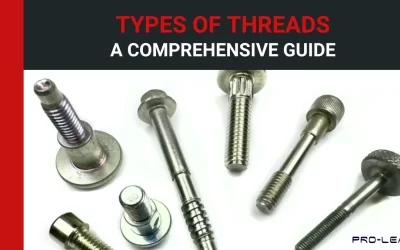
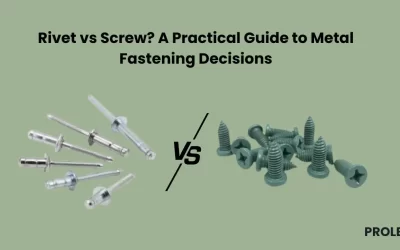
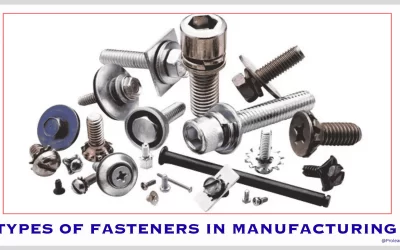
0 Comments